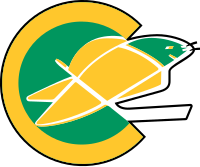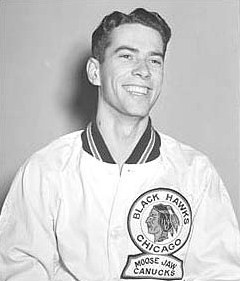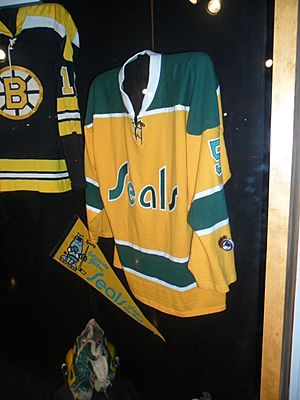California Golden Seals facts for kids
Quick facts for kids California Golden Seals |
|
|---|---|
 |
|
| Founded | 1961 (WHL) 1967 (as NHL expansion team) |
| History | San Francisco Seals 1961–1966 (WHL) California Seals 1966–1967 (WHL) California Seals 1967 (NHL) Oakland Seals 1967–1970 (NHL) Bay Area Seals 1970 (NHL) California Golden Seals 1970–1976 (NHL) Cleveland Barons 1976–1978 (NHL) |
| Home arena | Oakland–Alameda County Coliseum Arena |
| City | Oakland, California |
| Colors | Kelly green, royal blue, white (1967–1970) Kelly green, California gold, snow white (1970–1974) Pacific teal, gold, white (1974–1976) |
| Stanley Cups | 0 |
| Conference championships | 0 |
| Division championships | 0 |
The California Golden Seals were a professional ice hockey team that played in the National Hockey League (NHL). They were based in Oakland, California. The team played from the 1967 season to the 1976 season. Their home games were at the Oakland–Alameda County Coliseum Arena.
The Seals were one of six new teams added to the NHL in 1967. They started as the California Seals. Later, they changed their name to the Oakland Seals during the 1967–68 season. In 1970, they briefly became the Bay Area Seals before changing to the California Golden Seals in the same year.
Sadly, the Seals were not very successful. They never had a winning season. They only made it to the playoffs twice in their nine years. Not many fans came to their games either. In 1976, the team moved and became the Cleveland Barons. That team also stopped playing two years later. The Seals were the only team from the 1967 expansion that never played in the Stanley Cup Finals.
Contents
The Seals' Story: From Start to Finish
How the Team Began

In 1966, the NHL decided to add six new teams. This was to make the league bigger and stop another league, the WHL, from becoming a major league. The San Francisco Seals were a team from the WHL.
A businessman named Barry Van Gerbig bought the WHL Seals. He wanted to bring them into the NHL. He planned for the team to play in a new arena in San Francisco. But that arena was never built. So, he moved the team to Oakland to play in the new Oakland–Alameda County Coliseum Arena. He called them the California Seals. This name was meant to attract fans from all over California.
A year later, the Seals joined the NHL. They picked players in the 1967 NHL Expansion Draft. But the older NHL teams, called the "Original Six," kept their best players. So, the Seals mostly picked older players or those who played in minor leagues. To keep some familiar faces for fans, the team also kept some players from their WHL days.
The Bay Area was not a big hockey market. Even though the WHL Seals had many fans, the NHL team in Oakland did not. The plan to get fans from San Francisco didn't work. So, on November 6, 1967, the team changed its name to the Oakland Seals. This was to focus more on fans in the East Bay area.
Tough Times for the Team
The Oakland Seals still struggled to attract fans. Because of this, owner Barry Van Gerbig often talked about moving the team. Their first coach, Bert Olmstead, even suggested moving to Vancouver. Other cities like Buffalo also wanted the team. But the NHL did not want the team to move. They wanted to keep a team in California for their TV deal.
The team's poor performance and low attendance led to many changes. After the first season, only 7 of the 20 players stayed. The team made the playoffs for two years, but they still had losing records. These were the only two times the team reached the playoffs.
In 1969, a new group bought the team. But they ran into financial problems and gave the team back to Van Gerbig. He then put the team up for sale again.
Charles O. Finley Takes Over
Before the 1970–71 season, Charles O. Finley bought the Seals. He was also the owner of the famous Oakland Athletics baseball team. Finley was known for his flashy ideas.
Finley first renamed the team the "Bay Area Seals" for the 1970–71 season. But after only two games, on October 16, 1970, he changed the name again to the "California Golden Seals." He also changed the team's colors to green and gold, matching his popular A's baseball team.
The Seals are famous for wearing white skates, but Finley first tried green and gold ones. He also added player names to the back of jerseys, which was a new idea at the time. He even let players fly first class on planes. Despite these changes, the Seals had the worst record in the NHL that year. One of their worst trades happened when they gave up a future draft pick to the Montreal Canadiens. The Canadiens used that pick to choose Guy Lafleur, who became a Hall of Fame player.
The NHL Takes Over and the End of the Team
The team played a bit better in 1971–72. But then a new league, the World Hockey Association (WHA), started. Many Seals players left to play for the WHA because they offered more money. Without their best players, the Seals became one of the worst teams again. They stayed at the bottom of the league for the rest of their time.
Finley eventually got tired of the struggling hockey team. He tried to sell the Seals. When no one wanted to buy the team and keep it in the Bay Area, he sold it back to the NHL. The league then ran the team for over a year.
In 1975, a group led by Melvin Swig bought the team. He wanted to move the team to a new arena in San Francisco. But after a local election, the plans for the new arena were canceled. With no new arena, the league allowed the team to move.
The Final Chapter
Even though more fans were starting to come to games, the team's minority owners, George and Gordon Gund, convinced Swig to move the team to their hometown of Cleveland. The Seals played their last game in Oakland on April 4, 1976. The league approved the move, and the team was renamed the "Cleveland Barons".
The Barons also struggled in Cleveland. After two more years of losses and even worse attendance than in Oakland, the Gunds were allowed to combine the Barons with another struggling team, the Minnesota North Stars. This happened on June 14, 1978. The combined team continued as the Minnesota North Stars. Later, the North Stars moved to Texas and became the Dallas Stars.
The Cleveland Barons are the most recent team in a major North American sports league to completely stop playing.
The Seals' Lasting Impact
The current NHL team in the Bay Area, the San Jose Sharks, has a connection to the Seals. Years after the Barons-North Stars merger, the Gund brothers wanted to bring hockey back to the Bay Area. They asked the NHL to move the North Stars there. But the league didn't want to move a team from a traditional hockey city like Minnesota.
Eventually, a deal was made. The Gunds sold their share of the North Stars. In return, they got a new expansion team in the Bay Area, which became the Sharks. The Sharks started playing in the 1991–92 season. Interestingly, for their first two seasons, the Sharks played their home games at the Cow Palace in Daly City. This was the same arena the NHL had rejected for the Seals in 1967.
Dennis Maruk was the last player who played for the Seals to still be active in the NHL. He retired in 1989.
Even though the team is no longer active, the Seals are still remembered. Books and documentaries have been made about them. In 2016, a tribute website, GoldenSealsHockey.com, was created. The San Jose Sharks even wore a special jersey in 2022 that looked like the Golden Seals' uniform from their later years.
Seals' Season Records
Here's how the California Golden Seals performed each season:
| NHL season | Team name | Games played | Wins | Losses | Ties | Points | Goals for | Goals against | Penalty minutes | Finish | Playoffs | |
| 1967–68 | California/Oakland Seals1 | 74 | 15 | 42 | 17 | 47 | 153 | 219 | 787 | 6th in West | Did not qualify | |
| 1968–69 | Oakland Seals | 76 | 29 | 36 | 11 | 69 | 219 | 251 | 811 | 2nd in West | Lost in Quarterfinals (Kings), 3–4 | |
| 1969–70 | Oakland Seals | 76 | 22 | 40 | 14 | 58 | 169 | 243 | 845 | 4th in West | Lost in Quarterfinals (Penguins), 0–4 | |
| 1970–71 | Bay Area Seals/California Golden Seals2 | 78 | 20 | 53 | 5 | 45 | 199 | 320 | 937 | 7th in West | Did not qualify | |
| 1971–72 | California Golden Seals | 78 | 21 | 39 | 18 | 60 | 216 | 288 | 1,007 | 6th in West | Did not qualify | |
| 1972–73 | California Golden Seals | 78 | 16 | 46 | 16 | 48 | 213 | 323 | 840 | 8th in West | Did not qualify | |
| 1973–74 | California Golden Seals | 78 | 13 | 55 | 10 | 36 | 195 | 342 | 651 | 8th in West | Did not qualify | |
| 1974–75 | California Golden Seals | 80 | 19 | 48 | 13 | 51 | 212 | 316 | 1,101 | 4th in Adams | Did not qualify | |
| 1975–76 | California Golden Seals | 80 | 27 | 42 | 11 | 65 | 250 | 278 | 1,058 | 4th in Adams | Did not qualify | |
| Team moved to Cleveland | ||||||||||||
| Total | 9 seasons | 698 | 182 | 401 | 115 | 479 | 1,826 | 2,580 | 8,037 | |||
Notes:
- 1 The team was called California Seals from October 11 to November 6, 1967.
- 2 The team was renamed California Golden Seals after two games in the season.
Team Records
These records include the time the team played as the Cleveland Barons (1976–78).
Career Records:
- Most games played: Bob Stewart (414)
- Most goals: Dennis Maruk (94)
- Most assists: Al MacAdam (129)
- Most points: Al MacAdam (217)
- Most penalty minutes: Bob Stewart (691)
- Most wins by a goalie: Gilles Meloche (93)
- Most losses by a goalie: Gilles Meloche (191)
- Best goals against average (GAA) by a goalie: Charlie Hodge (3.09)
- Most shutouts by a goalie: Gilles Meloche (11)
- Most minutes played by a goalie: Gilles Meloche (20,666)
- Most wins by a coach: Fred Glover (96)
- Most losses by a coach: Fred Glover (206)
Single Season Records:
- Most goals: Dennis Maruk (36 in 1977–78)
- Most assists: Dennis Maruk (50 in 1976–77)
- Most points: Dennis Maruk (78 in 1976–77)
- Most wins by a goalie: Gary Smith (21 in 1968–69)
- Most losses by a goalie: Gary Smith (48 in 1970–71)
- Best goals against average (GAA) by a goalie: Charlie Hodge (2.86 in 1967–68)
- Most shutouts by a goalie: Gary Smith (4 in 1968–69) and Gilles Meloche (4 in 1971–72)
Top Scorers
These are the top ten players who scored the most points for the franchise, including their time in Cleveland.
| Player | Position | Games played | Goals | Assists | Points | Penalty minutes |
|---|---|---|---|---|---|---|
| Al MacAdam | RW | 320 | 88 | 129 | 217 | 214 |
| Dennis Maruk | C | 236 | 94 | 117 | 211 | 162 |
| Joey Johnston | LW | 288 | 84 | 101 | 185 | 308 |
| Ted Hampson | C | 246 | 61 | 123 | 184 | 37 |
| Bill Hicke | RW | 262 | 79 | 101 | 180 | 155 |
| Walt McKechnie | C | 250 | 62 | 109 | 171 | 124 |
| Dave Gardner | C | 289 | 67 | 99 | 166 | 33 |
| Gerry Ehman | RW | 297 | 69 | 86 | 155 | 56 |
| Rick Hampton | LW | 285 | 56 | 96 | 152 | 125 |
| Carol Vadnais | D | 246 | 63 | 83 | 146 | 560 |
Important People and Players
Hall of Fame Members
These people connected to the Seals are in the Hockey Hall of Fame:
- Harry Howell
- Bert Olmstead (he was a coach for the Seals, but is in the Hall of Fame as a player)
- Craig Patrick (inducted as a builder, meaning he helped build the sport)
- Rudy Pilous (inducted as a builder)
- Bill Torrey (inducted as a builder)
Team Captains
The players who were team captains for the Seals:
- Bobby Baun, 1967–68
- Ted Hampson, 1968–71
- Carol Vadnais, 1971–72
- Bert Marshall, 1972–73
- Joey Johnston, 1974–75
- Jim Neilson and Bob Stewart, 1975–76 (they were co-captains)
General Managers
The general managers who ran the Seals team:
- Rudy Pilous, 1967
- Bert Olmstead, 1967–68
- Frank Selke Jr., 1968–70
- Bill Torrey, 1970
- Fred Glover, 1970–71
- Garry Young, 1971–72
- Fred Glover, 1972–74
- Garry Young, 1974
- Bill McCreary, 1974–76
First Round Draft Picks
Players the Seals picked in the first round of the NHL draft:
- 1967: Ken Hicks (third overall)
- 1968: none
- 1969: Tony Featherstone (seventh overall)
- 1970: Chris Oddleifson (10th overall)
- 1971: none
- 1972: none
- 1973: none
- 1974: Rick Hampton (third overall)
- 1975: Ralph Klassen (third overall)
Broadcasters
People who called the Seals' games on TV and radio:
- In 1967–68, KTVU 2 showed 12 games with Tim Ryan as the play-by-play announcer.
- In 1968–69, away games were on KEEN radio, also with Tim Ryan.
- In 1969–70, Saturday and Sunday games were on KGO radio. Announcers included Jim Gordon, Bill Schonely, and Bill McColgan.
- In 1970–71, Roy Storey was on KEEN radio, and Rick Weaver called 10 games on KTVU.
- In 1972–73, Joe Starkey called games on KEEN radio. Jon Miller called 15 games on KFTY 50.
- Starkey continued to call games on KEEN in 1974–75 and 1975–76.
- In the Seals' last season, their games were on KBHK-TV 44.
See also
 In Spanish: California Golden Seals para niños
In Spanish: California Golden Seals para niños
- List of California Golden Seals players
- List of California Golden Seals head coaches
- List of NHL players
- List of NHL seasons
- 1967 NHL expansion




